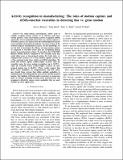Activity recognition in manufacturing: the roles of motion capture and sEMG+inertial wearables in detecting fine vs gross motion
Author(s)
Kubota, Alyssa; Iqbal, Tariq; Shah, Julie A; Riek, Laurel D.
DownloadAccepted version (4.074Mb)
Terms of use
Metadata
Show full item recordAbstract
In safety-critical environments, robots need to reliably recognize human activity to be effective and trust-worthy partners. Since most human activity recognition (HAR) approaches rely on unimodal sensor data (e.g. motion capture or wearable sensors), it is unclear how the relationship between the sensor modality and motion granularity (e.g. gross or fine) of the activities impacts classification accuracy. To our knowledge, we are the first to investigate the efficacy of using motion capture as compared to wearable sensor data for recognizing human motion in manufacturing settings. We introduce the UCSD-MIT Human Motion dataset, composed of two assembly tasks that entail either gross or fine-grained motion. For both tasks, we compared the accuracy of a Vicon motion capture system to a Myo armband using three widely used HAR algorithms. We found that motion capture yielded higher accuracy than the wearable sensor for gross motion recognition (up to 36.95%), while the wearable sensor yielded higher accuracy for fine-grained motion (up to 28.06%). These results suggest that these sensor modalities are complementary, and that robots may benefit from systems that utilize multiple modalities to simultaneously, but independently, detect gross and fine-grained motion. Our findings will help guide researchers in numerous fields of robotics including learning from demonstration and grasping to effectively choose sensor modalities that are most suitable for their applications.
Date issued
2019Department
Massachusetts Institute of Technology. Computer Science and Artificial Intelligence LaboratoryJournal
International Conference on Robotics and Automation (ICRA)
Publisher
IEEE
Citation
Kubota, Alyssa, et al., "Activity recognition in manufacturing: the roles of motion capture and sEMG+inertial wearables in detecting fine vs gross motion." 2019 International Conference on Robotics and Automation (ICRA), May 20-24, 2019, Montreal, QC, IEEE, 2019: p. 6533-39 doi 10.1109/ICRA.2019.8793954 ©2019 Author(s)
Version: Author's final manuscript
ISBN
978-1-5386-6027-0
ISSN
2577-087X